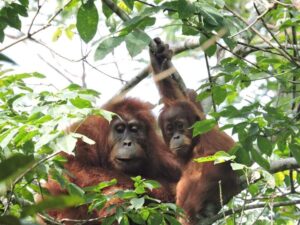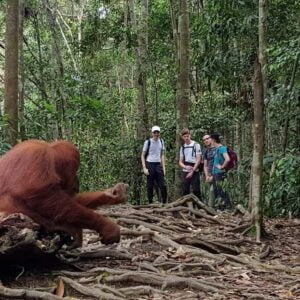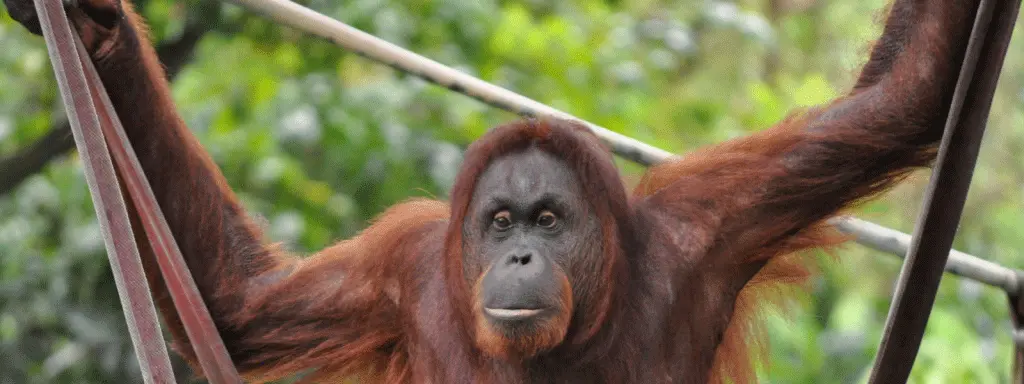Zoo vs. Rescue Centre vs. Sanctuary: Understanding the Key Differences When we think about places that house wild animals, terms…

Where to See Orangutans in Borneo Ethically
Quick Summary
- Ethical Orangutan Tourism: The post emphasizes the importance of choosing ethical experiences to see critically endangered orangutans in Borneo, distinguishing between wild, semi-wild (rehabilitation centers), and captive environments.
- Top Wild Sighting Locations: It highlights prime locations in Sabah, Malaysian Borneo, for spotting wild orangutans, including the Kinabatangan River, Danum Valley, Tabin Wildlife Reserve, and Deramakot Forest Reserve, along with guidelines for respectful encounters.
- Role of Rehabilitation Centers: The post also discusses ethical rehabilitation centers like Sepilok, Semenggoh, and Matang, detailing their crucial role in rescue, rehabilitation, and conservation awareness, while providing guidelines for responsible visitor interaction.
Why is Borneo so special for spotting orangutans?
Do you wonder where to see orangutans in the wild? Few experiences in the world are as awe-inspiring as witnessing an orangutan in its natural habitat. The lush rainforests of Borneo are one of the last homes for wild orangutans and one of the best places when considering where to see orangutans. Once, orangutans ranged throughout forests in Southeast Asia to southern China, but they have rapidly declined. Nowadays, orangutans are found only on two islands – Borneo and Sumatra.
From the lower Kinabatangan River to the remote Danum Valley, Borneo offers some of the world’s best places to see orangutans in their natural habitat. However, while Borneo has risen in popularity as a tourist destination, it also faces environmental threats. Choosing ethical wildlife experiences that protect these incredible creatures and their fragile habitats is more important than ever.
 Borneo is the third-largest island in the world, and it is shared between Malaysia, Indonesia, and Brunei. Likewise, it is home to the Bornean orangutan (Pongo pygmaeus), a critically endangered species with an estimated population of around 104,700 left in the wild (source: WWF) – just a century ago, their population was over double. These primates love to spend their days up in the forest canopy, building new nests, and foraging for food such as fruits, insects, and leaves. Orangutans are known to be one of the most intelligent primates, with both social and physical intellect.
Borneo is the third-largest island in the world, and it is shared between Malaysia, Indonesia, and Brunei. Likewise, it is home to the Bornean orangutan (Pongo pygmaeus), a critically endangered species with an estimated population of around 104,700 left in the wild (source: WWF) – just a century ago, their population was over double. These primates love to spend their days up in the forest canopy, building new nests, and foraging for food such as fruits, insects, and leaves. Orangutans are known to be one of the most intelligent primates, with both social and physical intellect.
The landscape and, therefore, the natural habitat of orangutans have been drastically impacted over the last few decades. Some of the greatest threats to Borneo’s rainforests are logging, land-clearing, and conversion activities. As a consequence, orangutans have been pushed into small, fragmented areas. Conservation efforts have created protected areas and forest patches to protect orangutans among other species such as pygmy elephants, proboscis monkeys, and sun bears.
Wild vs. Semi-Wild vs. Captive
You’ll see orangutans described differently, but these labels matter, especially when deciding where to see orangutans ethically.
- Wild orangutans: These are orangutans born and living their entire lives in forests, with no direct contact with humans. They forage, build nests, and raise their young as they have for millions of years. Seeing a truly wild orangutan in its natural habitat is a deeply moving experience.
- Semi-wild orangutans: These individuals are often born in captivity, rescued from the illegal pet trade, or orphaned due to deforestation or poaching. After rehabilitation, they’re released into protected but human-managed areas. Many rely partially on supplemental feeding, and they may be more accustomed to human presence. However, it is not a performance, and human contact is minimised. While these rehab centres are crucial in orangutan conservation, the animals are not fully wild.
- Captive orangutans: Captive orangutans are found in zoos, rescue centres, or as pets. Despite being illegal and unethical, the demand for orangutans as exotic pets still exists. It is common for captive orangutans to suffer from poor mental and physical health, making the reintroduction to the wild challenging. Some captive orangutans may never get to experience life in the wild.
It’s important to understand what kind of experience you’re supporting. Wild sightings offer a natural encounter, while rehab centres can educate and support rescue work. Avoid places that let tourists touch, take selfies, or engage in any other suspicious actions that do not put the animals first. These types of places often advertise themselves as sanctuaries, yet they exploit animals.
Top locations to see wild orangutans in Borneo
Spotting orangutans in the wild requires resilience and some luck, but there are only a few experiences in the world as breathtaking as seeing them in their natural habitat. Venturing deep into Borneo’s dense jungle to track orangutans creates a soul-stirring experience unlike any rehabilitation centre visit. Keep in mind – you are the guest, stepping into their world, on their terms.
There are some things you need to decide, starting from whether you will visit the Malaysian part or the Indonesian part of Borneo. Malaysian Wildlife encourages you to visit Sabah or Sarawak, together known as East Malaysia. It has great and cheap flight connections from Kuala Lumpur, the capital of Malaysia. Additionally, the tourist infrastructure is more developed in this area, allowing you to take a step back and let our Malaysian Wildlife guides guide you into the world of orangutans.
If you are wondering where to see orangutans in the wild, the following places are considered among the most respected and rewarded.
The Kinabatangan River, Sabah
The Kinabatangan River, the second longest river in Malaysia, is famous for its high biodiversity. The riverside is buzzing with life, including orangutans swinging from tree to tree or traveling on the ground. This magical riverside is one of the easiest places to spot them, together with hornbills, pygmy elephants, crocodiles, and many more. Hop on the boat, grab a pair of binoculars, and start your wildlife journey.
Danum Valley, Sabah
Danum Valley is a pristine, primary rainforest and a true dream for anyone passionate about wildlife. Not only can you witness iconic orangutans, but also gibbons, red leaf monkeys, and a variety of birds. This place requires a bit more planning, as it is not the easiest place to get to – but what is waiting for you there makes the trip all worth it.
Tabin Wildlife Reserve, Sabah
In eastern Sabah, dense rainforests preserve Borneo’s vanishing wild species, including orangutans. It is one of the most well-known orangutan reserves, and accessible by a traditional wooden boat used to move around the rivers. However, you can also visit feeding stations where rehabilitated orangutans return for supplementary food.
Deramakot Forest Reserve, Sabah
A premier destination for observing wild orangutans in their natural habitat. Here you have an opportunity to join a trek or a safari – or why not both? This location is deep in the jungle and not easily accessible by public transport. Therefore, planning is required beforehand. However, it offers a more intimate alternative for those who are seeking it.
Orangutans are active during daylight hours when they are foraging for food and building a nest. Weather plays its part too – orangutans prefer sunny days and typically hide in their nests during cloudy or rainy periods. When fortune smiles and you encounter these magnificent creatures, follow these essential guidelines:
- Maintain a distance of at least 10 metres away (or 20 metres if you are feeling unwell).
- Limit your observation to a maximum of one hour per encounter.
- Never attempt to feed, touch, or call out to orangutans.
- Use quiet voices and avoid sudden movements.
- Always respect family bonds – never position yourself between mother and infant.
Ethical orangutan rehabilitation centres
Unfortunately, in today’s world, not all orangutans roam free or can return to the wild. Many of them have been orphaned by poaching or lost their homes due to deforestation. As a result, vital orangutan rehabilitation centres have been created. If you are looking for where to see orangutans who are being rescued and prepared for the possible rewilding, these centres are doing valuable work. They fulfil three crucial missions: rehabilitating rescued orangutans, advancing scientific understanding, and sparking conservation awareness among visitors. Therefore, visiting an ethical centre can be both educational and impactful. It is crucial that the centre prioritizes the well-being of orangutans and does not exploit them for tourism.
 Sepilok Orangutan Rehabilitation Centre, Sabah
Sepilok Orangutan Rehabilitation Centre, Sabah
Established in 1964, this groundbreaking sanctuary provides rehabilitation for 60-80 orangutans that live independently in the forest, alongside roughly 25 orphaned youngsters in dedicated nurseries.
The Semenggoh Nature Reserve, Sarawak
Located 24km from Kuching, the lush Semenggoh Nature Reserve welcomes visitors to learn about the rehabilitation of orangutans. Opening its doors in 1975, the Semenggoh Nature Reserve has rescued orphaned, injured, and illegally captured orangutans to the center. Today, it focuses on orangutan biology research, while providing a sanctuary for semi-wild orangutans.
Matang Wildlife Rescue Centre, Sarawak
A sanctuary for orangutans that have been injured, orphaned, or rescued. This centre relies on volunteers to assist with animal care, construction projects, and enrichment activities. This role is vital for the rehabilitation process and supports the main goal – reintroducing orangutans into their natural habitat.
If you are inspired to do more than just visit for a day, consider becoming an orangutan volunteer and be part of something that lasts a lifetime.
A few things are good to keep in mind when visiting a sanctuary. Here are some guidelines for responsible orangutan encounters:
- Maintain a distance from all orangutans.
- Do not touch or try to interact with the animals.
- Keep personal belongings secure to avoid attracting curious apes.
- Speak quietly and always follow your guide’s instructions.
These guidelines protect both orangutans and humans. Close contact harms orangutans, triggering stress, compromising maternal behaviours, and reducing survival chances upon release.
Your visit helps fuel these centres’ vital mission – returning orangutans to protected rainforests and providing a safe place for rehabilitation. The released orangutans prove that passion for conservation and working hard will make a difference. Your presence matters – supporting work that gives these remarkable beings a second chance at freedom.
Conclusion
Seeing an orangutan in Borneo is not only a bucket-list experience, but also a powerful reminder of what’s at stake. These intelligent and gentle animals are facing immense challenges, to which responsible tourism can be a part of the solution. Choose ethical encounters and support genuine conservation efforts, and help to protect Borneo’s rainforests together with the life they hold.
If you are dreaming of an unforgettable orangutan tour in Borneo that balances adventure and impact, join our Borneo Sepilok & Kinabatangan tour. It is a carefully designed journey that takes you deep into the orangutan territory, combining river safaris, tracking of wild orangutans (and the rest of Borneo’s big five!), and witnessing incredible work being done at the Sepilok Orangutan Rehabilitation Center. This trip lets you witness these incredible apes in two meaningful ways and directly contribute to their protection.
What better way to visit orangutans than by making your trip part of their survival story?









